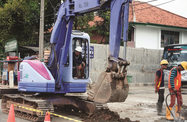Mongolia: Boosting local construction
A wave of new infrastructure and phased housing projects in Mongolia looks set to give the country’s construction sector a huge boost while also generating wide-ranging opportunities for foreign investors in the building industry.
Mongolia is rolling out an extensive programme of developments that includes the construction of roads, bridges and homes as it gears up for an anticipated natural resources boom that is expected to transform the economy and pave the way for widespread urbanisation.
The government is funding many of the projects through its mining sector and state budget but is also looking to attract investment from the private sector for developments that include the building of satellite cities to reduce population density, road networks and infrastructure for power.
While the huge volume of work spells good news for Mongolia’s builders, concern has been raised that the country’s construction sector will require an extensive overhaul before local firms can meet increased demand for infrastructure. Some observers have also suggested that efforts to tap foreign investment need to be stepped up if Mongolia is to attract companies with the necessary expertise.
At the beginning of April, Mongolia’s Cabinet identified a list of several “urgent” roads and bridges to be built. It also announced that 5572 km of roads and 900 km of highways connecting Ulaanbaatar with aimags (provinces) would be restored under the umbrella of the country’s MNT4.9trn ($3.75bn) “New Up Building” programme, which is spearheading much of the country’s mid-term development.
While MNT4.57trn ($3.5bn) will be drawn from the mining sector for the programme, MNT22.9bn ($17.5m) of funding is expected to come from foreign and domestic investment, according to officials. The mission director of the Asian Development Bank (ADB), Robert Shoelhammer, meanwhile, announced at the end of March that the institution would play a key part in driving forward efforts to modernise the capital’s public transport system and develop the ger (yurt) areas where 60% of the city’s population live.
The capital city is expected to see much of the new development. The mayor of Ulaanbaatar, G. Munkhbayar, outlined 115 new construction and transport projects earmarked for the capital that are scheduled to be completed by 2030 at an estimated cost of $9.9bn. Approximately 42% of the population currently lives in the city and this number is expected to rise to 55% over the next 18 years. One of the capital’s largest ongoing construction projects, the “Homes for 100,000 Households” programme, is set to enter its next phase following Prime Minister S. Batbold’s confirmation in March that the green light had been given for the building of a second wave of new apartments. The government has already increased the number of homes in the first order from 79,000 to 124,000, according to The Ulaanbaatar Post.
Batbold said that the second order of homes, which would be built around the city and in rural areas, were aimed primarily at households on small or medium-sized incomes, with almost half the number of apartments expected to be less than 55 sq metres in size. The programme is one of a number of key projects, alongside railways, roads and the Sainshand Industrial Complex, being funded by bonds issued by the Development Bank.
The president of the Mongolian Builder’s Association, M. Batbaatar, highlighted the positive impact the new wave of activity would have on the industry, telling OBG, “For the next 15 years, this programme will give us work.”
But while the construction sector looks set to play a vital role in Mongolia’s development, analysts believe the industry could be held back by challenges in key areas, such as capacity and regulatory constraints, shortages of materials and manpower, and transportation bottlenecks.
A report issued by the World Bank in February showed that construction activity in the country dropped 20.5% in a year-on-year comparison in the fourth quarter of 2011. It also pointed out that only 5% of licensed domestic road construction companies were found capable of large construction projects. “The government would need to urgently address the following areas in order to expand road sector capacity successfully: company capabilities and capacity, business and government policy, funding and performance, labour force, and construction materials,” it said.
There are signs that Mongolia is opening up to foreign investment as opportunities become available, such as the announcement in February that the US-based firm FLSmidth had won a $112m contract with the local Mongolyn Alt Group to supply a greenfield cement plant some 330 km from Ulaanbaatar. Once built, the plant should have a 3000-tonnes-per-day supply capacity.
However, while the cost of cement and bricks has fallen in recent years, the cost of other, mostly imported, materials has fluctuated, prompting concern from industry players that domestic production of key supplies is insufficient. Although the government’s initiatives are expected to fuel considerable growth in construction, the call is growing for greater efforts to be made to attract more foreign investment and expertise that would bolster the sector’s prospects in the long term.


